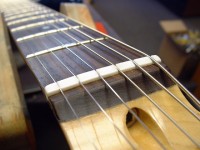
The proximity of the strings to the frets is referred to as the action. This is dictated by three elements; the truss-rod and the amount of neck relief it enables, the height of the bridge and the depth of the nut slots. Most guitars come with a nominal set-up – the action is left rather higher than is strictly necessary – the idea being that it can be tailored to suit individual playing styles.
Set-ups have traditionally been offered, where necessary , by the better music shops, some of whom have the luxury of an in-house guitar tech. It’s a relatively simple procedure to carry out but cutting the string slots in the nut requires the use of delicate gauged, round-edged nut files which, at £15-£20 per string, are quite an investment.
It’s an inescapable fact that the harder the strings are hit the more they move and the more room is required to accommodate this movement. A lot of people find it difficult to take on board that the way they play is the biggest component part of any set-up and it’s still not uncommon to hear customers asking for the action to be set as low as possible without any buzz, forgetting that a low action requires them to play with a light touch. For harder players, the only way to have a low action – without the attendant fret buzz – is to use heavier gauge strings. The greater tension required to get them up to the same pitch restricts their lateral movement.

As well as the strings being set for height they also have to be adjusted longitudinally for correct intonation. On most electric instruments this involves using individual saddle screws to alter the length of the string. If the note, at the 12th fret sounds sharp when compared to it’s octave harmonic (pluck gently, over the 12th position, without fretting) the string’s playing length is too short. If the note sounds flat then it needs to be reduced.
Setting the intonation on an acoustic guitar is much more of a compromise, where altering the string’s break point over the saddle is usually the only practical means of adjustment.
The three key parameters involved in a set-up must be considered in the correct order, namely.
1)The amount of neck relief (via adjustable truss-rod).
2)The height of the bridge (via height adjustment screws).
3)The depth of the nut slots (using special nut files).